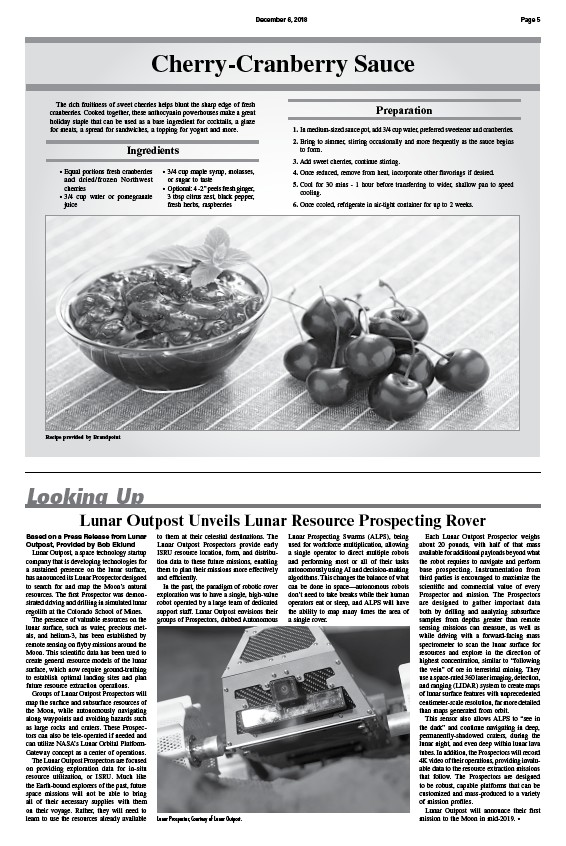
December 6, 2018 Page 5
Cherry-Cranberry Sauce
The rich fruitiness of sweet cherries helps blunt the sharp edge of fresh
cranberries. Cooked together, these anthocyanin powerhouses make a great
holiday staple that can be used as a base ingredient for cocktails, a glaze
for meats, a spread for sandwiches, a topping for yogurt and more.
Ingredients
Preparation
Recipe provided by Brandpoint
1. In medium-sized sauce pot, add 3/4 cup water, preferred sweetener and cranberries.
2. Bring to simmer, stirring occasionally and more frequently as the sauce begins
to form.
3. Add sweet cherries, continue stirring.
4. Once reduced, remove from heat, incorporate other flavorings if desired.
5. Cool for 30 mins - 1 hour before transferring to wider, shallow pan to speed
cooling.
6. Once cooled, refrigerate in air-tight container for up to 2 weeks.
• Equal portions fresh cranberries
and dried/frozen Northwest
cherries
• 3/4 cup water or pomegranate
juice
• 3/4 cup maple syrup, molasses,
or sugar to taste
• Optional: 4 -2” peels fresh ginger,
3 tbsp citrus zest, black pepper,
fresh herbs, raspberries
Looking Up
Lunar Outpost Unveils Lunar Resource Prospecting Rover
Based on a Press Release from Lunar
Outpost, Provided by Bob Eklund
Lunar Outpost, a space technology startup
company that is developing technologies for
a sustained presence on the lunar surface,
has announced its Lunar Prospector designed
to search for and map the Moon’s natural
resources. The first Prospector was demonstrated
driving and drilling in simulated lunar
regolith at the Colorado School of Mines.
The presence of valuable resources on the
lunar surface, such as water, precious metals,
and helium-3, has been established by
remote sensing on flyby missions around the
Moon. This scientific data has been used to
create general resource models of the lunar
surface, which now require ground-truthing
to establish optimal landing sites and plan
future resource extraction operations.
Groups of Lunar Outpost Prospectors will
map the surface and subsurface resources of
the Moon, while autonomously navigating
along waypoints and avoiding hazards such
as large rocks and craters. These Prospectors
can also be tele-operated if needed and
can utilize NASA’s Lunar Orbital Platform-
Gateway concept as a center of operations.
The Lunar Outpost Prospectors are focused
on providing exploration data for in-situ
resource utilization, or ISRU. Much like
the Earth-bound explorers of the past, future
space missions will not be able to bring
all of their necessary supplies with them
on their voyage. Rather, they will need to
learn to use the resources already available
to them at their celestial destinations. The
Lunar Outpost Prospectors provide early
ISRU resource location, form, and distribution
data to these future missions, enabling
them to plan their missions more effectively
and efficiently.
In the past, the paradigm of robotic rover
exploration was to have a single, high-value
robot operated by a large team of dedicated
support staff. Lunar Outpost envisions their
groups of Prospectors, dubbed Autonomous
Lunar Prospecting Swarms (ALPS), being
used for workforce multiplication, allowing
a single operator to direct multiple robots
and performing most or all of their tasks
autonomously using AI and decision-making
algorithms. This changes the balance of what
can be done in space—autonomous robots
don’t need to take breaks while their human
operators eat or sleep, and ALPS will have
the ability to map many times the area of
a single rover.
Each Lunar Outpost Prospector weighs
about 20 pounds, with half of that mass
available for additional payloads beyond what
the robot requires to navigate and perform
base prospecting. Instrumentation from
third parties is encouraged to maximize the
scientific and commercial value of every
Prospector and mission. The Prospectors
are designed to gather important data
both by drilling and analyzing subsurface
samples from depths greater than remote
sensing missions can measure, as well as
while driving with a forward-facing mass
spectrometer to scan the lunar surface for
resources and explore in the direction of
highest concentration, similar to “following
the vein” of ore in terrestrial mining. They
use a space-rated 360 laser imaging, detection,
and ranging (LIDAR) system to create maps
of lunar surface features with unprecedented
centimeter-scale resolution, far more detailed
than maps generated from orbit.
This sensor also allows ALPS to “see in
the dark” and continue navigating in deep,
permanently-shadowed craters, during the
lunar night, and even deep within lunar lava
tubes. In addition, the Prospectors will record
4K video of their operations, providing invaluable
data to the resource extraction missions
that follow. The Prospectors are designed
to be robust, capable platforms that can be
customized and mass-produced to a variety
of mission profiles.
Lunar Outpost will announce their first
mission to the Lunar Prospector, Courtesy of Lunar Outpost. Moon in mid-2019. •